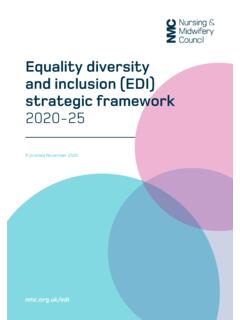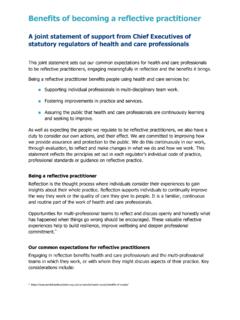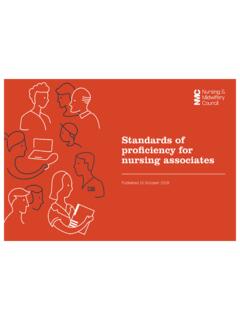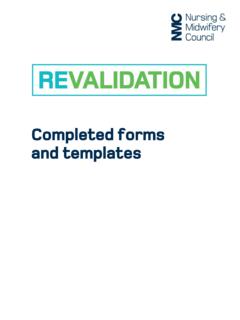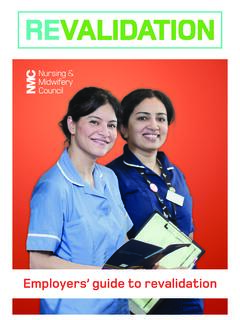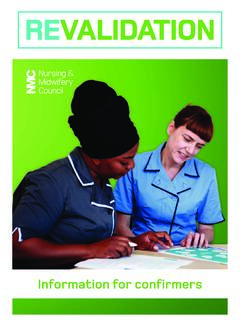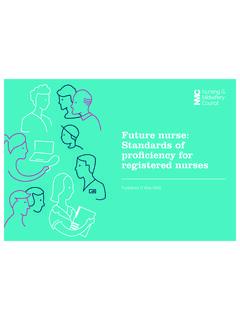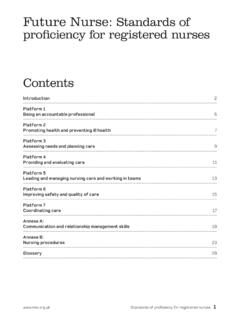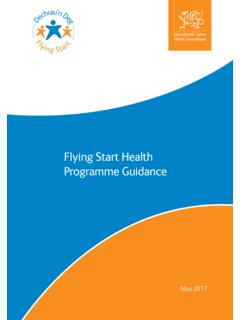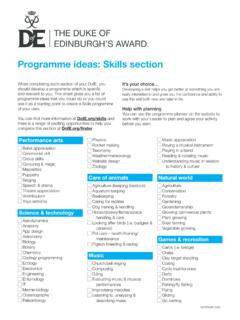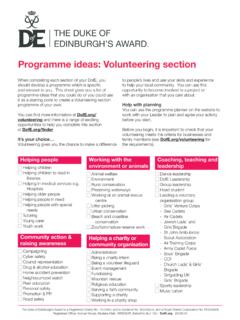Transcription of Principles for preceptorship
1 Principles for preceptorship2 Our new Principles for preceptorship have been developed in collaboration with the Chief Nursing Officers (CNOs) in the four countries of the UK, the Chief Midwifery Officers in England and Scotland and Lead officers for midwifery in Northern Ireland and Wales. We are grateful for their support on this important work. The preceptorship Principles have been developed in recognition of the benefits that a supported, structured period of preceptorship brings to employers, preceptees, and people who use SutcliffeChief Executive and Registrar 3 IntroductionThis document sets out a series of Principles which can be applied in preceptorship programmes for newly registered nurses, midwives and nursing associates1 joining the NMC register. It sets out the purpose of preceptorship , who it s for and the Principles which support its implementation in practice at employer and/or region or country wide this document, professionals engaged on preceptorship programmes are referred to as preceptees.
2 Those who support preceptees are referred to as preceptors and the period of preceptorship is called the preceptorship programme . These Principles will help preceptees, preceptors, employers and organisations, students, practitioners, professional regulators, system regulators, educators and others to think about how they can best support newly registered nurses, midwives and nursing associates. The objectives of preceptorship are to welcome and integrate the newly registered nurse, midwife and nursing associate into the team and place of work, help them grow in confidence, and begin their lifelong journey as an accountable, independent, knowledgeable and skilled practitioner. 1 Nursing associates are registered in England only4 preceptorship may vary in length to meet the needs of the preceptee and individual countries, regions or organisations may set minimum and/or maximum durations for the preceptorship period.
3 It s important to recognise that preceptorship is not intended to repeat or re-test any applied knowledge and skills required for NMC registration at pre or post-registration level. preceptorship provides a structured and useful adjunct to individual performance appraisal processes, and formal employer and organisational induction and mandatory training. This document sets out a common set of Principles for organisations and employers that can be used to develop an effective model of preceptorship . They will help organisations and employers think about what they need to do to achieve consistently high quality and effective preceptorship for every newly registered nurse, midwife and nursing associate in the UK. While this document is framed in the context of newly registered nurses, midwives and nursing associates, the Principles can also usefully be applied to those joining a new part of the NMC register, those returning to practise after re-joining the register and nurses, midwives and nursing associates coming to work in the UK from within or outside the , midwives and nursing associates who are self-employed or intending to practise infrequently should arrange to receive support in line with these takes account of the setting in which the individual is working and providing care.
4 It will reflect the health and social care landscape in each of the four countries of the UK including the NHS, the social care sector, and the independent and charitable journey from pre-qualification to regulated professional It s important to recognise that the experience a newly registered nurse, midwife or nursing associate has in the period directly after initial registration is significantly important and can positively influence their journey to becoming a confident the point of registration, newly registered nurses, midwives and nursing associates have the knowledge, skills and behaviours required to join the professional register. preceptorship then offers the structured support needed for new nurses, midwives and nursing associates to successfully convert this knowledge into everyday practice, and gain confidence in their ability to use their knowledge and skills and consistently apply the Code on a day to day basis.
5 The preceptorship period provides the basis for the beginning of a lifelong journey of reflection, and the ability to self-identify continuing professional development needs, as the nurse, midwife and nursing associate embarks on their career and prepares for revalidation. 6 The benefits of preceptorship Within the UK it s recognised that a supported, structured period of preceptorship has a variety of benefits for employers, preceptees, and people who use registered nurses, midwives and nursing associates are conscious of the need for support at this time of new employment and the availability of good quality preceptorship will influence their employment choices and selection. A positive preceptorship experience is reported to result in newly registered nurses, midwives and nursing associates having increased confidence and sense of belonging, feeling valued by their employer, and having greater professional and team identity.
6 Effective preceptorship outcomes are linked to improved recruitment and retention. Attracting and retaining skilled nurses, midwives and nursing associates is important for delivering better, safe and effective care. 7 Principles of preceptorship12354 Organisational culture and preceptorshipQuality and oversight of preceptorshipPreceptee empowermentPreparing preceptors for their supporting roleThe preceptorship programme 8 Organisational culture and preceptorshipA period of preceptorship immerses the newly registered nurse, midwife and nursing associate into their professional role and into the ways of working and culture of their new workplace. A good organisational culture that supports preceptorship will have the following characteristics: It is kind, fair, impartial, transparent, collaborative and fosters good interprofessional and multi-agency relationships There is an understanding of the importance of having systems and processes in place to support and build confidence of newly registered nurses, midwives and nursing There is an approach to preceptorship that prioritises individual mental and physical health and wellbeing, and promotes accountability, self-reflection and safe practice in accordance with the and oversight of preceptorshipBeing committed to the Principles of preceptorship and having preceptorship programmes available/running are seen as key activities within the organisation.
7 There is evidence of management of the process, and evaluation of its efficacy and ensure effective There are processes in place to identify those who require preceptorship There is sufficient preceptor capacity to support all of those who require The employer, preceptees and preceptors understand and comply with national and local policies, and the relevant governance requirements required by the four countries of the preceptorship activities should complement the preceptees induction and orientation into the local There is recognition of the impact of system challenges on effective preceptorship and how to mitigate Processes are in place to monitor, evaluate and review preceptorship There is a governance framework around preceptorship which allows the process to be audited and is tailored to the individual nurse, midwife and nursing associate preceptee s new role and the health or care setting.
8 It seeks to recognise and support the needs of the preceptee to promote their confidence in their professional healthcare role. In effective preceptorship models, Are provided with the appropriate resources to enable them to develop confidence as newly registered nurses, midwives and nursing associates Are supported according to their individual learning Are supported by a nominated Have opportunities for reflection and feedback to support their approach to preparing for Are empowered to work in partnership with preceptors and are able to influence the content and length of their preceptorship programme to meet both individual and organisational empowerment311 Preceptors should receive appropriate preparation to understand and undertake their role. In effective preceptorship models, Act as professional role Receive ongoing support and actively engage in professional development Are supportive and constructive in their approach to the Share effective practice and learn from Seek and are given feedback on the quality of all aspects of their preceptorship role.
9 Preparing preceptors for their supporting rolePreceptee empowerment412 The preceptorship programme preceptorship should take account of the setting in which the individual nurse, midwife and nursing associate is working and providing care. These Principles apply to any health or social care setting across UK, including the NHS, the social care sector, and the independent and charitable sectors. preceptorship programmes Be timely and align with the start of a new employment Recognise the knowledge, skills, attributes and competence nurses, midwives and nursing associates have at the point of Seek to ensure that activities within the programme are agreed with the individual preceptee Vary in length and content according to the needs of the individual nurse, midwife and nursing associate and the organisation.
10 Individual countries, regions or organisations may set minimum or maximum lengths for preceptorship Include activities designed to welcome and integrate the preceptee into the team and place of Be designed to ensure that it is possible for the preceptee to meet the aims and outcomes of the preceptorship programme within the agreed country arrangements for employer led clinical supervision for midwivesIn 2017 the four countries of the UK introduced employer led models of supervision. These models focus on supporting and developing effective midwifery practice. Further information is available via the following links:EnglandA-EQUIP (Advocating and Educating for Quality Improvement)midwifery supervision IrelandFramework for Supervision: Midwifery, Nursing and supervision for Supervision for Midwives (CSfM): A Model for wide information on preceptorshipEnglandHealth Education England (2018) RePAIR: Reducing Pre-registration Attrition and Improving Retention: Health Education England, preceptorship Employers: Preceptorships for newly qualified staff IrelandNIPEC, preceptorship Framework Education for Scotland, Flying start NHS Welsh Government, Core Principles for preceptorship 15 Useful referencesAllan, , Magnusson, C.
